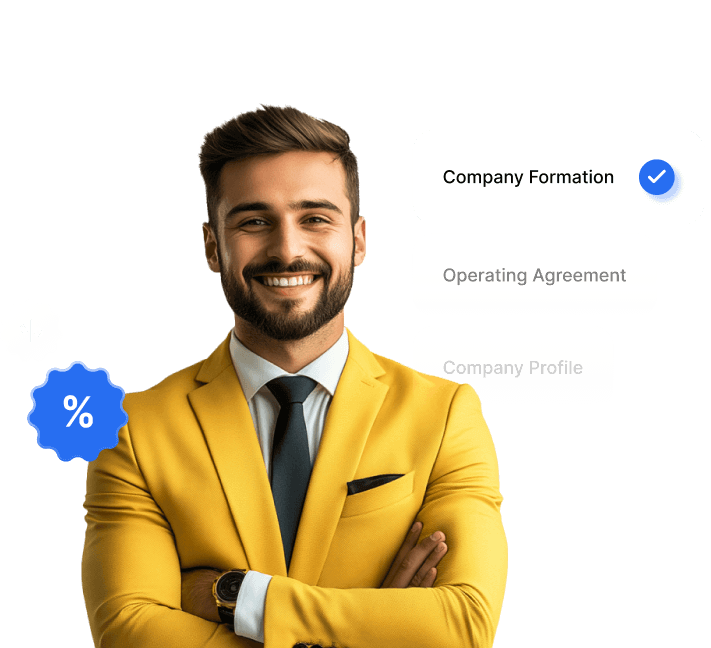Language:
What Is a Sole Proprietorship?

There is a slew of business entities to choose from, but today, we’re talking all about sole proprietorships and how their business structure could benefit your venture.
Get ready to dive into the world of sole proprietorships, where you can be your own boss and single-handedly run the show while also being in the know about everything that’s going on with your business.
How a Sole Proprietorship Works
A sole proprietorship is a business that’s owned and operated by one person, with that owner personally liable for all debts and obligations of the business. Similar to a single-member Limited Liability Company (LLC), but different in that if the business fails, the owner could lose their personal assets, such as their home or car.
We’ll go through all the pros and cons a little later. For now, let’s touch on some of the key features that make sole proprietorships a sought-out option for small and new business owners.
Transferability
Transferring ownership in a sole proprietorship isn’t as simple as just handing over the keys to the business. The business itself is defined by its owner, so passing membership over will have to be done by transferring the assets over to the new owner and then having the new owner form their own separate legal business structure to receive the assets.
This structure is a bit more complicated than an established business like an LLC or a corporation, where an operating agreement could lay out the terms of transferability.
Duration
The lifespan of a sole proprietorship is indefinite, meaning it last for as long as the owner wants it to. The owner can sell the business, close it down, or transfer ownership to someone else at any time.
However, some events could automatically terminate a sole proprietorship, such as the death or incapacity of the owner.
If an owner passes away, the business will be passed on to their heirs, and if the owner becomes incapacitated, they may be unable to continue running the business, leaving it to either be transferred to someone else or dissolved completely.
Capital Requirements
You can kick off your business journey with whatever funds you have at hand, there’s no minimum capital requirement for starting a sole proprietorship.
However, you’ll have to take into account the type of business that you’re starting up and the potential funds you’ll need to get it started. If you’re starting a product-based business, you’ll need money set aside for any equipment, materials, and time needed to assemble your product (whether physical or digital). A service based-business sometimes doesn’t have as many upfront costs, but you’ll still need to consider marketing tools like a website and domain and any subscription-based programs you’ll need to effectively do your job.
So, what’s the magic number for your sole proprietorship’s capital? Well, it all boils down to your specific business and its needs. Before diving in, do your homework and ensure you have enough funds to get your business up and running smoothly.
Registration and Licensure
Unlike registered business entities, sole proprietorships don’t technically need to be registered by the state to be considered sole proprietorships. Once the business becomes more serious, you’ll want to ensure you have the proper registrations and licensures to operate legally. Some businesses might need none, while others might need a few. These may include:
- Business Name Registration: In some states, you may need to register your business name with the state to prevent other businesses from using the same name.
- Business Licenses: You may need to obtain a business license from your city or county to operate your business, like a liquor license for a bar or cafe.
- Permits: You might need specific permits that require you to create or distribute foods, build homes, or work in a specific realm.
These are just a few common registration and licensure requirements for sole proprietorships. The specific requirements will vary depending on your location and the type of business you are operating. To be sure about what you need, contact your local government to get all the specifics to ensure you comply with the law.
Taxation
Now let’s talk taxes. Sole proprietorships (just like LLCs) are considered “pass-through” entities, which means your business income and expenses go straight to your personal tax return, and you pay taxes on the net income (income after expenses).
Here are a few tax tidbits to keep in mind for sole proprietorships:
- You can deduct business expenses from your personal income taxes to reduce your taxable income, which could include everything from rent to utilities to equipment and marketing costs. (You might even be able to deduct health insurance premiums from your personal income taxes.)
- As a self-employed business owner, you’re required to pay self-employment taxes, which include Social Security and Medicare taxes, at the current rate of 15.3%.
Chat with a tax advisor to ensure you’re making the most of all deductions and credits at your disposal.
Owner vs Proprietor: What’s the Difference?
What sets a business owner and a proprietor apart? It’s all about the ownership structure. While business owners can join forces with partners or shareholders, proprietors fly solo, since they’re the proprietor of an unincorporated business structure. This also means that proprietors face unlimited personal liability for business debts, while business owners with partners or shareholders might enjoy limited liability.
Here is an overview:
Business Owner
- Can have partners or shareholders
- Has limited personal liability (only has a limited amount of personal assets they could be sued for)
- Makes all the business decisions
- Can be an individual, partnership, or corporation
Proprietor
- Is the sole owner of the business
- Has unlimited personal liability (could be sued for their personal assets)
- Makes all the business decisions
- Must be an individual
How to Start a Sole Proprietorship
You’re sold! A sole proprietorship is calling your name. Now what?
- Pick a catchy business name. Make it unique and memorable. To check if your dream name is available, search your state’s Secretary of State website so you can ensure you’re choosing a unique name in your state.
- Grab that business license (if you need one). Depending on your city or county, you might need a business license. Requirements vary, so make sure to do some research.
- Open a business bank account. Keep your personal and business finances separate for smoother tracking of income and expenses.
- Register for a free Employer Identification Number (EIN) from the Internal Revenue Service (IRS).
- Set up a bookkeeping system. Stay on top of your business income and expenses to make tax prep a breeze.
- Develop a marketing plan for your business. With the legal and financial stuff sorted, let the world know about your amazing venture through a website, social media, or even print ads.
- Get business-specific insurance. Protect yourself, your work, and your workers from unexpected events.
Obtaining Business Licenses and Permits
Familiarize yourself with your local government’s website (or in-person office) to get all your questions answered and get all the licenses and permits you need to run your business legally. Expect to fill out some paperwork including an application and some potential fees to receive your license to operate.
Operating Under an Assumed Name
You might have heard an assumed name also be called a DBA, or a Doing Business As. It’s a name that builds a professional image around your business, without your technically needing to register your business like with a sole proprietorship (or a partnership).
To operate under an assumed name, simply file a DBA form with your local government based on their specific requirements, and voilà, you can use your assumed name or DBA on your business documents like your invoices, contracts, and marketing materials without any issues.
Getting an EIN
An EIN or an Employer Identification Number is a unique number meant to help identify your business on tax documents. If you’re a sole proprietor with employees, you’ll need an EIN from the IRS so they can file in the spring.
You can get your EIN for your sole proprietorship by:
- Applying online on the IRS official website
- Applying by phone at 267-941-1099
- Applying by mail with form SS-4
In no time, the IRS will email you your EIN for you to apply to your invoices, taxes, and more!
Advantages of Sole Proprietorship
Still weighing your options on whether a sole proprietorship is best? Here are some pros:
- It’s inexpensive to form. Unlike other business structures, setting up a sole proprietorship is probably the simplest process of them all. By starting a business, you’re automatically a sole proprietor without needing to pay anything for filing.
- It’s a simple business structure. Sole proprietorships are a simple option that you can keep simple now and always scale later.
- You, as the owner, have total control. Unlike a partnership where you share joint ownership, you can make the rules of how you run your own business.
- You can deduct business expenses. Investing in your business, even from seemingly required investments like health insurance or marketing materials, can help you pay fewer taxes in the spring.
- You can pay your business’s taxes on your personal income tax return. There is no need to file two tax forms as you can put all of your sole proprietorship records on your personal tax returns and you’ll be good to go.
Disadvantages of Sole Proprietorship
- The owner has unlimited personal liability. As a sole proprietor, you’re personally responsible for all of the business’s debts and obligations. This means that if your business gets sued or can’t pay its bills, your personal assets (such as your home or car) may be at risk. When you’ve established yourself in a Limited Liability Company, you’re minimizing your personal liability.
- You might have difficulty obtaining financing. Without an established business, growing your entrepreneurial work could be challenging, from trying to get a business bank account to taking out a business loan.
- It’s difficult to switch ownership. If you feel like you might want to eventually transfer ownership or go into business with someone else, consider the headache of having to transfer assets to another business owner for them to bring them into their own, new business.
Form Your Sole Proprietorship the Easy Way
When starting a small business there are lots of boxes to check before launching. Keep it simple at first, and as your business grows, then you can expand to other business entities that fit the needs of your business.
Let us take the stress of forming your business structure and managing your finances. With doola, we’ll help you organize your sole proprietorship so you can focus on running your business, not crunching numbers.
FAQs
How are sole proprietorships taxed?
Sole proprietorships are taxed as pass-through entities, which means that the income and expenses of the business are reported on the owner’s personal tax return (LLCs are the same way).
Do sole proprietorships have limited liability?
No, sole proprietorships do not have limited liability, they have unlimited liability. This means that the owner of the business is personally liable for all debts and obligations of the business.
Can you change a sole proprietorship to an LLC?
Yes, you can do this by filing the articles of organizations within your state to officially establish your business.
Is a single-member LLC a sole proprietorship?
No, a single-member LLC isn’t the same as a sole proprietorship. A single-member LLC is an established business structure that stands for limited liability company, while a sole proprietorship is an unestablished business structure.




